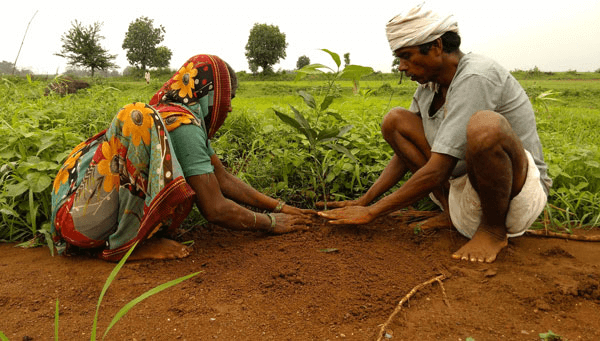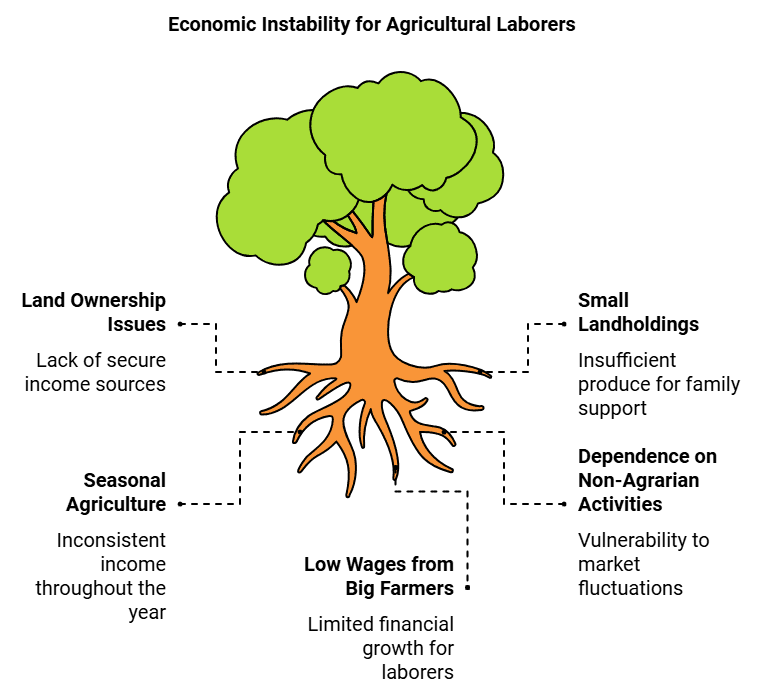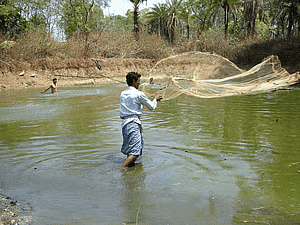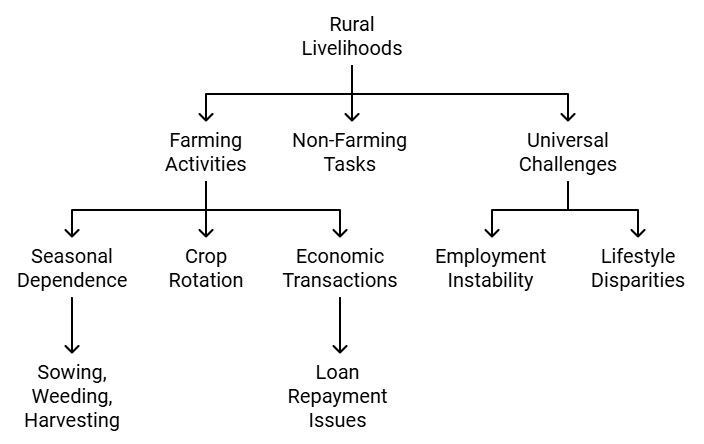Class 6 Exam > Class 6 Notes > Chapter Notes For Class 6 > Chapter Notes: Rural Livelihoods
Class 6 Civics Chapter 7 Notes - Rural Livelihoods
Kalpattu village
- Location and Geography: Kalpattu is a small village near the coast in Tamil Nadu, surrounded by low hills.
- Primary Occupation: Agriculture is the main occupation of the villagers.
- Crops Grown: The villagers predominantly grow paddy, with rice being the major crop. Other crops include coconut, mangoes, cotton, sugarcane, and plantains.
- Diverse Professions: Villagers engage in various occupations, such as crafting utensils, pots, bricks, and baskets.
- Skilled Artisans: Some residents work as blacksmiths, washermen, weavers, barbers, and cycle repair mechanics.
- Local Trade: Traders run small shops selling clothes, groceries, tea, seeds, fertilizers, etc.
- Food Stalls: Stalls selling local snacks like idli, dosa, upama, bonda, mysore pak, and vadai are common.
- External Employment: In addition to local economic activities, some villagers travel to nearby towns for work, such as construction jobs, lorry driving, and vehicle repairs.
 Fig: Rural areas
Fig: Rural areas
Example 1: Thulasi
- Work Schedule: Thulasi, a poor woman, works on Ramalingam's land from 8:30 AM to 4:30 PM.
- Seasonal Employment: She is employed during specific seasons, mainly from June to November, assisting in transplanting crops, weeding, and harvesting.
- Low Wages: Despite her hard work, Thulasi earns only forty paisa per day, significantly less than the wages of laborers in other villages.
- Husband’s Occupation: Her husband, Raman, works as a laborer, specializing in spreading pesticides in the fields during these months.
- Domestic Responsibilities: Thulasi also manages all household chores, including looking after her family, washing clothes, cleaning the house, gathering firewood, and fetching water from a borewell one kilometer away. Raman assists in carrying groceries.
- Children's Education: Their daughters, a source of joy, attend school.
- Financial Hardships: The family's limited income is insufficient for their needs, leading Thulasi to borrow money from Ramalingam for her daughters' medical expenses.
- Thulasi’s Struggles: Her story reflects the common struggles of poor rural families, who spend much of their time collecting firewood and water.
- Rural Labor Demographics: About two-fifths of the rural population consists of agricultural laborers, some owning small plots of land while others work on lands owned by others.
- Labor Migration: To earn a livelihood, these laborers often travel long distances, with such migrations being particularly common during certain seasons.
Example 2 : Sekar
- Land Ownership and Size: Sekar, a small farmer, and his family own a two-acre piece of land.
- Self-Reliance in Agriculture: They personally handle all the agricultural tasks on their land.
- Collaborative Harvesting: During the harvest season, Sekar enlists the help of other farmers, reciprocating by working in their fields as well.
- Post-Harvest Process: After harvesting, Sekar and his family transport the paddy from the field to their home.
- Seed and Fertilizer Purchase: To buy seeds and fertilizers, Sekar sells a portion of his grains to traders at a lower price, while storing the remaining paddy for his family’s consumption.
- Additional Employment: For supplementary income, Sekar works in Ramalingam’s rice mill, where he is responsible for collecting paddy from nearby villages.
- Livestock and Dairy Income: The family owns hybrid cows and sells the milk to cooperatives, helping to cover their basic daily needs.
Being in Debt
- Loan Necessity for Farmers: Farmers like Sekar in rural areas often need to take loans for purchasing seeds, fertilizers, and agricultural equipment.
- Risks of Poor Quality Seeds and Pests: These farmers face risks such as bad quality seeds, pest attacks on paddy fields, or scanty rainfall leading to crop failure.
- Inability to Repay Loans: Such adverse circumstances prevent farmers from repaying the borrowed money to moneylenders or traders.
- Increasing Debt: As a result of these challenges, the farmers' debt continues to rise.
- Financial Distress and Tragic Consequences: The escalating financial distress due to unmanageable debt often leads these farmers to commit suicide.
- Prevalence Across the Country: Such incidents are reported in various parts of the country.
Example 3 : Ramalingam and Karuthamma
- Financial Stability: Ramalingam enjoys a more stable financial condition compared to agricultural laborers.
- Diverse Income Streams: His income comes from multiple sources, including agricultural land, a rice mill, and a shop that sells pesticides and seeds to farmers.
- Mill Operations: To operate his rice mill, Ramalingam invests both his personal funds and loans obtained from government banks.
- Paddy Collection: He gathers paddy from his own village as well as neighboring villages for processing.
- Primary Income Source: The sale of rice to traders in nearby towns serves as his major source of income.
Question for Chapter Notes: Rural LivelihoodsTry yourself: What is the primary occupation of the villagers in Kalpattu village?View Solution
Agricultural Laborers and Farmers in India

- Land Ownership in Rural Areas: Most rural inhabitants do not own land and instead cultivate on fields owned by others.
- Small Farmers' Challenges: A significant portion, 80%, of farmers in India have small landholdings, which do not yield enough produce to support their entire family.
- Big Farmers' Status: The remaining 20% of farmers, like Ramalinga, are big farmers who own larger tracts of land, employ laborers at low wages, and may also own factories. They often sell their products directly in markets and earn additional income by lending money to small farmers.
- Agriculture's Seasonal Nature: Due to agriculture being seasonal, poor people cannot rely on it for year-round income.
- Non-Agrarian Income Sources: To supplement their income, rural residents engage in various non-agrarian activities:
- In Central India, forest resources like mahua leaves, tendua, and honey are key income sources, sold to traders.
- Animal husbandry, dairy production, and fishing are other significant occupations.
- Some families raise cows and goats, selling milk to village cooperatives or nearby towns.
Coastal dwellers, such as those in Pudupet near Kalpattu, predominantly engage in fishing and trading fish on the sea beach.
Fig: Coastal areas
Example 4 : Aruna and Perarivalan
- Residence and Occupation: Aruna resides in Pudupet, near Kalpattu, with her family, who are engaged in fishing for a living.
- Family Involvement in Fishing: Her husband Perarivelan, along with her brother and brother-in-law, are involved in the actual fishing process at sea.
- Aruna's Role: Aruna's primary responsibility is to sell the fish they catch.
- Income Distribution: The earnings from the fish sales are divided into four equal parts: one part for each person involved in fishing, and the fourth part is allocated for purchasing fishing equipment.
- Ownership of Equipment: As Aruna and her husband own the fishing equipment, they receive the fourth share of the income for equipment expenses.
- Restricted Fishing Season: During the breeding season, which lasts about four months, they are prohibited from fishing, leading to a loss of income during this period.
- Loan and Repayment System: To compensate for this income gap, they borrow money from traders and repay these loans by selling their catch to the same traders.
Rural Livelihoods
- Livelihood Activities: Rural inhabitants engage in a variety of livelihood activities, including farming and non-farming tasks.
- Seasonal Dependence: Their activities and expenses are heavily influenced by the agricultural seasons, focusing on sowing, weeding, and harvesting at specific times of the year.
- Crop Rotation: Different crops are cultivated in different seasons due to the dependence on natural factors.
- Universal Challenges: Despite the diversity in their activities, rural people face similar challenges and difficulties.
- Land Ownership and Labor: Individuals with small landholdings use them for cultivation, while those without land work as laborers on others' properties.

- Economic Transactions: Small farmers often sell their produce to traders, reserving a portion for personal use.
- Loan Repayment Issues: A significant problem is the repayment of loans, often leading to selling crops to moneylenders at below-market prices.
- Income Alternatives: To supplement their income, rural residents explore alternative options.
- Employment Instability: Agricultural laborers, fishing families, and craftspeople face irregular employment and struggle to make ends meet.
- Lifestyle Disparities: There is a contrast in lifestyles, with big farmers and those involved in business and factory ownership generally leading better lives.
The document Class 6 Civics Chapter 7 Notes - Rural Livelihoods is a part of the Class 6 Course Chapter Notes For Class 6.
All you need of Class 6 at this link: Class 6
FAQs on Class 6 Civics Chapter 7 Notes - Rural Livelihoods
| 1. What are the main sources of income for rural households in India? |  |
Ans. The main sources of income for rural households in India include agriculture, livestock rearing, fishing, and small-scale industries. Many families engage in farming as their primary occupation, while others may work as agricultural laborers or in related sectors.
| 2. How does debt affect farmers in rural areas? |  |
Ans. Debt can significantly impact farmers by causing financial stress and limiting their ability to invest in their farms. It often leads to a cycle of borrowing, where farmers may take loans to pay off previous debts, which can result in loss of land or other assets if they are unable to repay.
| 3. What challenges do agricultural laborers face in Kalpattu village? |  |
Ans. Agricultural laborers in Kalpattu village often face challenges such as low wages, lack of job security, seasonal employment, and inadequate access to resources like education and healthcare, which can affect their livelihoods and overall well-being.
| 4. How does rural livelihood differ from urban livelihood? |  |
Ans. Rural livelihood primarily focuses on agriculture and natural resources, while urban livelihood often revolves around industries, services, and trade. Rural areas may have limited job opportunities compared to urban areas, leading to different economic conditions and lifestyle choices.
| 5. What role do women play in rural livelihoods in India? |  |
Ans. Women play a crucial role in rural livelihoods by participating in agricultural activities, managing household tasks, and often engaging in small-scale enterprises. They contribute significantly to food production and family income, although they may face challenges related to gender inequality and limited access to resources.
Related Searches

















